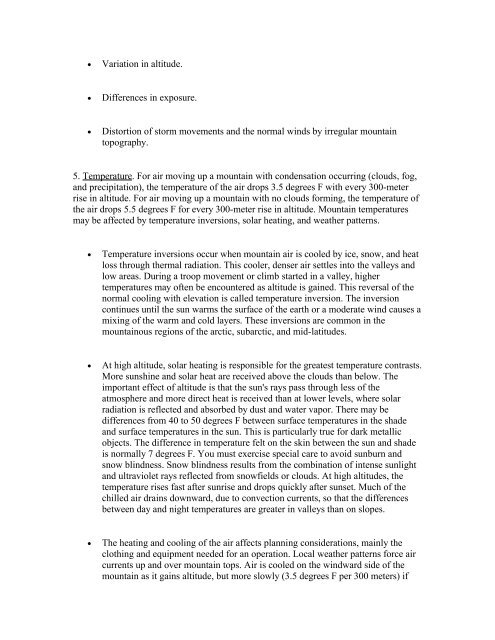US Army mountaineering techniques (basic)
US Army mountaineering techniques (basic)
US Army mountaineering techniques (basic)
You also want an ePaper? Increase the reach of your titles
YUMPU automatically turns print PDFs into web optimized ePapers that Google loves.
Variation in altitude.<br />
Differences in exposure.<br />
Distortion of storm movements and the normal winds by irregular mountain<br />
topography.<br />
5. Temperature. For air moving up a mountain with condensation occurring (clouds, fog,<br />
and precipitation), the temperature of the air drops 3.5 degrees F with every 300-meter<br />
rise in altitude. For air moving up a mountain with no clouds forming, the temperature of<br />
the air drops 5.5 degrees F for every 300-meter rise in altitude. Mountain temperatures<br />
may be affected by temperature inversions, solar heating, and weather patterns.<br />
Temperature inversions occur when mountain air is cooled by ice, snow, and heat<br />
loss through thermal radiation. This cooler, denser air settles into the valleys and<br />
low areas. During a troop movement or climb started in a valley, higher<br />
temperatures may often be encountered as altitude is gained. This reversal of the<br />
normal cooling with elevation is called temperature inversion. The inversion<br />
continues until the sun warms the surface of the earth or a moderate wind causes a<br />
mixing of the warm and cold layers. These inversions are common in the<br />
mountainous regions of the arctic, subarctic, and mid-latitudes.<br />
At high altitude, solar heating is responsible for the greatest temperature contrasts.<br />
More sunshine and solar heat are received above the clouds than below. The<br />
important effect of altitude is that the sun's rays pass through less of the<br />
atmosphere and more direct heat is received than at lower levels, where solar<br />
radiation is reflected and absorbed by dust and water vapor. There may be<br />
differences from 40 to 50 degrees F between surface temperatures in the shade<br />
and surface temperatures in the sun. This is particularly true for dark metallic<br />
objects. The difference in temperature felt on the skin between the sun and shade<br />
is normally 7 degrees F. You must exercise special care to avoid sunburn and<br />
snow blindness. Snow blindness results from the combination of intense sunlight<br />
and ultraviolet rays reflected from snowfields or clouds. At high altitudes, the<br />
temperature rises fast after sunrise and drops quickly after sunset. Much of the<br />
chilled air drains downward, due to convection currents, so that the differences<br />
between day and night temperatures are greater in valleys than on slopes.<br />
The heating and cooling of the air affects planning considerations, mainly the<br />
clothing and equipment needed for an operation. Local weather patterns force air<br />
currents up and over mountain tops. Air is cooled on the windward side of the<br />
mountain as it gains altitude, but more slowly (3.5 degrees F per 300 meters) if

















